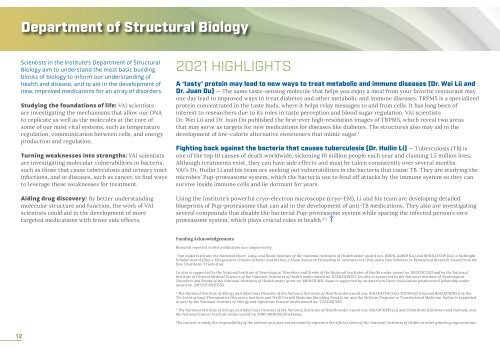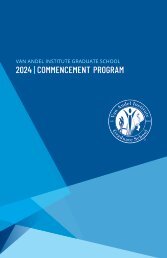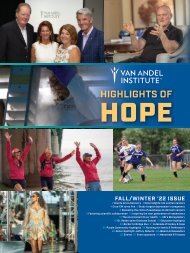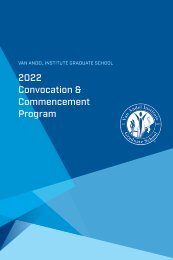2021 Annual Report
This is the 2021 Annual Report for Van Andel Institute.
This is the 2021 Annual Report for Van Andel Institute.
You also want an ePaper? Increase the reach of your titles
YUMPU automatically turns print PDFs into web optimized ePapers that Google loves.
Department of Structural Biology<br />
Scientists in the Institute’s Department of Structural<br />
Biology aim to understand the most basic building<br />
blocks of biology to inform our understanding of<br />
health and disease, and to aid in the development of<br />
new, improved medications for an array of disorders.<br />
Studying the foundations of life: VAI scientists<br />
are investigating the mechanisms that allow our DNA<br />
to replicate as well as the molecules at the core of<br />
some of our most vital systems, such as temperature<br />
regulation, communication between cells, and energy<br />
production and regulation.<br />
Turning weaknesses into strengths: VAI scientists<br />
are investigating molecular vulnerabilities in bacteria,<br />
such as those that cause tuberculosis and urinary tract<br />
infections, and in diseases, such as cancer, to find ways<br />
to leverage these weaknesses for treatment.<br />
Aiding drug discovery: By better understanding<br />
molecular structure and function, the work of VAI<br />
scientists could aid in the development of more<br />
targeted medications with fewer side effects.<br />
<strong>2021</strong> HIGHLIGHTS<br />
A ‘tasty’ protein may lead to new ways to treat metabolic and immune diseases (Dr. Wei Lü and<br />
Dr. Juan Du) — The same taste-sensing molecule that helps you enjoy a meal from your favorite restaurant may<br />
one day lead to improved ways to treat diabetes and other metabolic and immune diseases. TRPM5 is a specialized<br />
protein concentrated in the taste buds, where it helps relay messages to and from cells. It has long been of<br />
interest to researchers due to its roles in taste perception and blood sugar regulation. VAI scientists<br />
Dr. Wei Lü and Dr. Juan Du published the first-ever high-resolution images of TRPM5, which reveal two areas<br />
that may serve as targets for new medications for diseases like diabetes. The structures also may aid in the<br />
development of low-calorie alternative sweeteners that mimic sugar. 1<br />
Fighting back against the bacteria that causes tuberculosis (Dr. Huilin Li) — Tuberculosis (TB) is<br />
one of the top 10 causes of death worldwide, sickening 10 million people each year and claiming 1.5 million lives.<br />
Although treatments exist, they can have side effects and must be taken consistently over several months.<br />
VAI’s Dr. Huilin Li and his team are seeking out vulnerabilities in the bacteria that cause TB. They are studying the<br />
microbes’ Pup-proteasome system, which the bacteria use to fend off attacks by the immune system so they can<br />
survive inside immune cells and lie dormant for years.<br />
Using the Institute’s powerful cryo-electron microscope (cryo-EM), Li and his team are developing detailed<br />
blueprints of Pup-proteasome that can aid in the development of anti-TB medications. They also are investigating<br />
several compounds that disable the bacterial Pup-proteasome system while sparing the infected person’s own<br />
proteasome system, which plays crucial roles in health. 2,3<br />
Funding Acknowledgements<br />
Research reported in this publication was supported by:<br />
1<br />
Van Andel Institute; the National Heart, Lung, and Blood Institute of the National Institutes of Health under award nos. R56HL144929 (Lü) and R01HL153219 (Lü); a McKnight<br />
Scholar Award (Du); a Klingenstein-Simons Scholar Award (Du); a Sloan Research Fellowship in neuroscience (Du); and a Pew Scholars in Biomedical Research Award from the<br />
Pew Charitable Trusts (Du).<br />
Lü also is supported by the National Institute of Neurological Disorders and Stroke of the National Institutes of Health under award no. R01NS112363 and by the National<br />
Institute of General Medical Sciences of the National Institutes of Health under award no. R35GM138321. Du also is supported by the National Institute of Neurological<br />
Disorders and Stroke of the National Institutes of Health under grant no. R01NS111031. Ruan is supported by an American Heart Association postdoctoral fellowship under<br />
award no. 20POST35120556.<br />
2<br />
The National Institute of Allergy and Infectious Diseases of the National Institutes of Health under award nos. R01AI143714 (Lin), R21144552 (Lin) and R01AI070285 (Li); the<br />
Tri-Institutional Therapeutics Discovery Institute and Weill Cornell Medicine Matching Fund (Lin); and the Milstein Program in Translational Medicine. Kahne is supported<br />
in part by the National Institute of Allergy and Infectious Disease under award no. T32AI007180.<br />
3<br />
The National Institute of Allergy and Infectious Diseases of the National Institutes of Health under award nos. R01AI070285 (Li) and U19AI111143 (Glickman and Nathan); and<br />
the National Cancer Institute under award no. P30CA008748 (Glickman).<br />
The content is solely the responsibility of the authors and does not necessarily represent the official views of the National Institutes of Health or other granting organizations.<br />
12

















